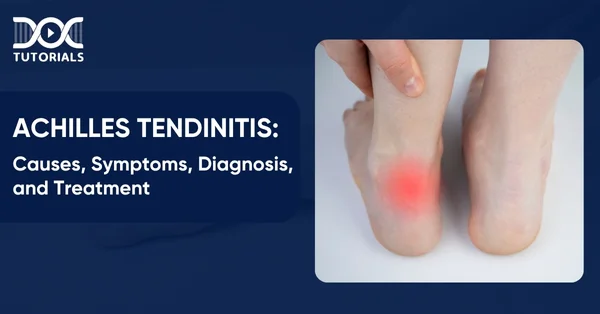Achilles Tendinitis: Causes, Symptoms, Diagnosis, and Treatment

Achilles tendinitis is a condition where the Achilles tendon linking the calf muscles to the heel becomes irritated or swollen. Runners who suddenly intensify their training and middle-aged individuals who participate in sports on weekends are often affected.
If Achilles tendinitis is allowed to progress, it causes loss of motion, stiffness, pain and swelling around the back of the heel. Learning about its causes and symptoms and understanding the treatments is crucial for students preparing for the NEET PG exam.
Keep reading to understand more about Achilles tendinitis, its causes, symptoms, diagnosis and treatment options.
What is Achilles Tendinitis?
Achilles tendinitis is the inflammation of the Achilles tendon — the strong band of tissue that connects the calf muscles to the heel bone. This tendon helps lift the heel off the ground during walking, running or jumping.
This swelling happens as part of the body’s natural recovery response to injury. It can cause stiffness, tenderness or a burning sensation in the back of the lower leg. Achilles tendinitis is sometimes referred to as Achilles tendinopathy, a broader term that encompasses chronic tendon damage or degeneration.
What are the Different Types of Achilles Tendinitis?
The Achilles tendinitis is divided into 2 types, which are:
- Noninsertional Achilles Tendinitis
This type develops in the middle of the Achilles tendon. The fibres in this area start to break down, causing swelling, thickening and pain. It’s more common in younger, active people who do repetitive, high-impact activities.
- Insertional Achilles Tendinitis
In this type, inflammation happens where the tendon is attached to the heel bone, right at its base. It can happen to anyone, even inactive people, but it’s more common in people who overuse the tendon, like long-distance runners.
What Causes Achilles Tendinitis?
Achilles tendinitis develops when the Achilles tendon is subjected to repeated stress, which causes irritation, swelling and inflammation. This tendon connects the calf muscles to the heel bone and is used in movements like walking, running, jumping and climbing stairs.
It’s common in people who suddenly increase the intensity or duration of physical activity, such as running faster or longer without proper conditioning. Middle-aged adults who play outdoor sports occasionally, on weekends, are also at risk.
What are the Risk Factors of Achilles Tendinitis?
Several risk factors are involved in Achilles tendinitis, including lifestyle habits, physical conditions, and certain medical issues. They are as follows:
- Sports and Exercise
- Playing sports that involve quick stops and starts, like basketball or tennis.
- Running, dancing or activities that put repetitive stress on the Achilles tendon.
- People who exercise infrequently tend to be less conditioned.
- Anatomy and Physical Issues
- Tight or weak calf muscles that put extra stress on the tendon.
- Flat feet or high arches affect how pressure is distributed when you walk or run.
- Overpronation (ankles rolling inward when you walk).
- Bone spurs on the heel rub against the tendon.
- Age and Previous Injuries
- Tendons get weaker with age, so older people are more at risk.
- The history of Achilles tendinitis increases the chance of recurrence.
- Training and Environmental Factors
- Running in worn-out shoes or poor running form.
- Exercising in cold weather which tightens the tendons.
- Running on hills adds extra stress.
- Medical Conditions and Medications
- Conditions like psoriasis, high cholesterol or high blood pressure.
- Certain antibiotics (fluoroquinolones) are linked to tendon problems.
What are the Common Symptoms of Achilles Tendinitis?
There are many common symptoms to look for to identify Achilles tendinitis. Some of the common symptoms include:
- Pain and stiffness along the Achilles tendon are particularly noticeable in the morning.
- Swelling around the tendon gets worse throughout the day.
- Tenderness or thickening of the tendon.
- Leg weakness or difficulty climbing stairs or walking uphill.
- People with insertional tendinitis often feel pain at the back of the heel, especially when wearing shoes.
- In some cases, bone spur formation can develop near the heel.
How is Achilles Tendinitis Diagnosed?
Diagnosing Achilles tendinitis starts with evaluating the symptoms and what the patient has been up to physically. Below are some of the diagnostic approaches:
- Physical Examination
- The doctor will press along the Achilles tendon to see if it’s tender or swollen.
- They’ll watch how the foot and ankle move at rest and during movement.
- Range of motion and strength tests may be done.
- Imaging Tests
- X-ray: X-rays do not show soft tissue but can show bone spurs or rule out other causes of pain.
- Ultrasound: Ideal for visualising soft tissue and capturing the real-time movement of the tendon. A Doppler ultrasound can check blood flow around the tendon.
- MRI (magnetic resonance imaging): This imaging technique provides detailed images of the Achilles tendon, helping to evaluate the severity of the injury.
- CT (computed tomography) Scan: Sometimes used for more complex cases, but not as common.
What are the Treatment Options for Achilles Tendinitis?
Treatment for Achilles tendinitis usually starts with non-surgical methods to reduce pain and inflammation while the tendon recovers. If symptoms have been present for a long time, recovery can take several months.
Listed below are a few of the common treatment options:
- Nonsurgical Treatments
- RICE Method
- Rest: Avoid activities that strain the tendon. Switch to low-impact exercises like swimming.
- Ice: Apply ice for up to 20 minutes several times a day to reduce swelling.
- Compression: Use an athletic wrap or surgical tape to support the tendon.
- Elevation: Keeping your foot raised above heart level can help reduce swelling.
- Protective Measures
- Don’t walk on steep inclines or overstretch the tendon.
- Use a night splint to keep the tendon gently stretched during sleep.
- In severe cases, a walking boot or cast might be needed to ease pain and promote healing.
- Additional Therapies
- NSAIDs (nonsteroidal anti-inflammatory drugs): Help manage pain and inflammation, but should not be used long term without medical advice.
- Physical Therapy: Includes strengthening exercises, stretches, massage and gait retraining.
- Shockwave Therapy: Uses sound waves to promote healing and reduce pain.
- Brisement: An injection of anaesthetic around the tendon to break down scar tissue in the early stage of tendinitis.
- Surgical Treatments
Surgery is considered if non-surgical treatments fail after several months. Some of the options are:
- Gastrocnemius Recession: This treatment includes lengthening of the calf muscles to reduce tension on the tendon.
- Debridement and Repair: This procedure removes damaged tendon tissue and repairs the healthier portion. After surgery, a boot or cast is typically worn for several weeks to allow proper recovery.
- Debridement with Tendon Transfer: Used when significant damage is present. A tendon from the big toe is moved to support the Achilles tendon.
- Hydrocision TenJet: A minimally invasive procedure that uses high-pressure saline to remove scar tissue while preserving healthy tissue.
How to Prevent Achilles Tendinitis?
There is no way to completely prevent Achilles tendinitis. There are certain habits and precautions which can reduce the risk. Below are some of the tips:
- Warm Up Properly: Stretch your calf muscles and Achilles tendon before and after exercise to loosen up.
- Increase Activity Gradually: Don’t make sudden changes in your workout intensity or duration. Give your tendon time to adjust.
- Wear Supportive Footwear: Choose shoes that cushion your heel and have good arch support. Ensure to replace worn-out shoes as soon as possible.
- Don’t Overload the Tendon
- Limit activities like hill running or repetitive jumping if you’re not conditioned for them.
- Train with low-impact exercise, for example, cycling or swimming.
- Strengthen Calf Muscles: Stronger calf muscles reduce the stress on the Achilles tendon during exercise.
- Stay Active Year Round: Keeping the muscles conditioned can help prevent injuries when you get back to sports after a break.
FAQs About Achilles Tendinitis
1. How common is Achilles tendinitis?
Achilles tendinitis is super common, especially in active people and athletes. Around 24% of athletes will get an Achilles tendon injury in their lifetime.
2. What causes Achilles tendinitis?
Achilles tendinitis happens when the tendon that connects the calf muscles to the heel bone is overused or strained without rest. It’s often due to repetitive stress, but it can also happen without a clear cause.
3. What’s the best exercise for Achilles tendinitis?
Heel raises on a step are the best exercise. For this, stand on the edge of a step, lift your heels slowly until you’re on your toes, then lower them back to the step. Do this 8 to 12 times for strength and flexibility.
4. How do you treat Achilles tendinitis fast?
Use the RICE method: Rest, ice, compression, and elevation. Switch to low-impact activities like swimming and don’t stress the tendon. Apply ice for up to 20 minutes several times a day to reduce pain and swelling.
Conclusion
Achilles tendinitis is a common yet manageable condition that affects athletes, active individuals and even those with less strenuous lifestyles. Early diagnosis and timely treatment are crucial for preventing complications and regaining mobility.
If you’re preparing for a career in medicine, at DocTutorials, you’ll find a vast library of topics covering NEET PG preparation, along with high-quality video lectures, question banks, test series and expert guidance for medical students.
Join DocTutorials today and explore our NEET PG course to excel in your medical career.
Latest Blogs
-

NEET PG Exam 2025- Date, Pattern, Marking Scheme, Subject Wise Weightage, and Exam Mode
NEET PG Exam 2025 is the ultimate gateway for medical graduates aspiring to pursue postgraduate courses in medicine, including MD,…
-

INI CET Exam 2025: Your Roadmap to Success – Key Topics, Strategies, and Lessons from Last Year’s Papers
The INI CET exam is more than just a test; it’s a significant milestone for many medical students aiming to…
-

INI CET Exam Success: Previous Year Question Papers & Ultimate Guide – INI CET PYQ
One can feel overwhelmed while preparing for the INI CET (Institute of National Importance Combined Entrance Test). A vast syllabus,…




